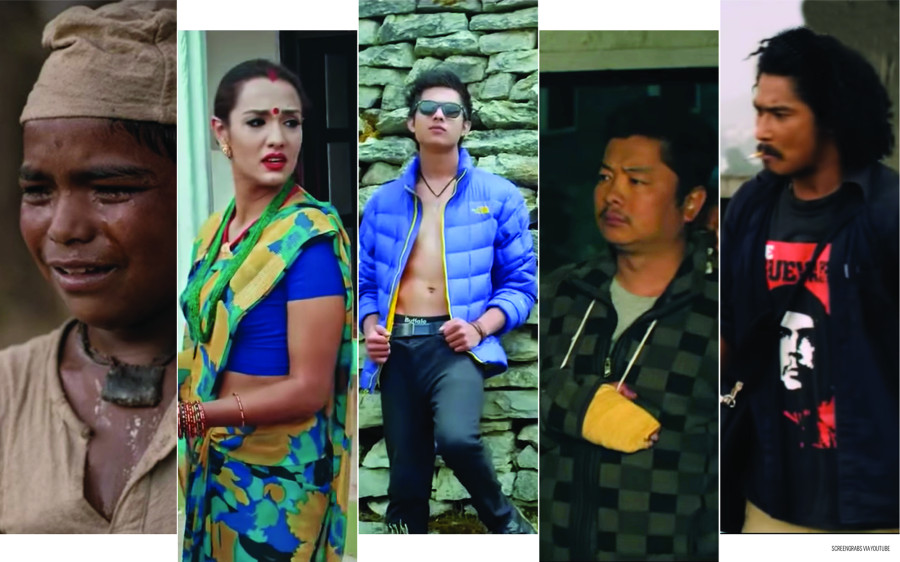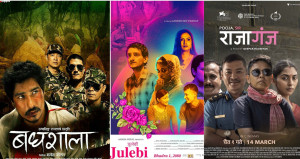Movies
Nine trends that defined Nepali films in the past decade
While the industry’s output is increasing, the quality is often questionable.
Abhimanyu Dixit
By the early 2010s, around 40 Nepali films were released each year. That number surged to more than 100 films in 2019. This is indicative of increasing interest from more exciting makers over the past decade.
Many individuals from a diverse milieu—short-film makers, film students, theatre professionals, music video makers, advertisement producers, film critics, television series producers, and even YouTubers—tried their hand at producing films for the big screen. All of them, in one way or the other, have shaped cinema in Nepal—whether by providing fresh talent on or off screen, by shaping the cinematic process, or by bringing their medium’s audience into cinema halls.
Albeit the arrival of such variegation, there were certain trends that dominated the Nepali film industry throughout the past decade. The categorisation of these trends, however, is my personal take and do not follow any scientific rubric. These definitions are an attempt to thoroughly comprehend and study the course taken by Nepali film since 2010. Hopefully it’ll point us to where Nepali cinema is headed.
Money-in-the-bag films
This category or trend was introduced by Loot (2012), and it changed Nepali cinema. Writer and director Nischal Basnet led the way by breaking Nepali narrative conventions, which usually feature a strong well-meaning, well-spoken hero. Basnet’s hero wasn’t good natured or even good looking, the characters talked like they were on the streets of Kathmandu, the fight scenes weren’t choreographed, and for a movie about looting; there wasn’t even one gun shot.
But watch the film today and you’ll realise Loot hasn’t aged well. And other films in this category follows a similar plot: a bunch of economically impoverished men living in narrow streets of Kathmandu mingle with criminals, because at the end of the day, everyone expects to get a share of the money.
This was a simple enough premise to take Loot to the box office, and for it to be a relative success, even though there were plenty of loopholes, but the films that followed, like Loot 2 (2017) and Jai Shree Daam (2018), couldn’t replicate its success—rather they are just bad. You’ll encounter traces of toxic masculinity, eve teasing, and glorification of violence on full display. The worst end of the stick is reserved for female characters, who are either objectified in item songs, or are loot for the male hero protagonists. This is actually true for the next category as well.
Ensemble comedies
Celebrities from Nepali theatre or TV, or both, come together in this genre to present a plot that centres on multiple characters. Here, the lead, mostly male, is a lovable baddie, and we follow his redemption arc through carefully planned moments of comedic cringe. Two film series under this category became commercially successful —Kabaddi and Chakka Panja.
While Kabaddi recycles the same old plot, the Chakka Panja series deals with specific issues in each of its films. And that’s all you get to learn—Nepal is full of issues.
The worst of this lot are the original Chakka Panja (2016), and Shatru Gate (2018)—both films with huge budgets which are perfect displays of mindless and offensive comedies.
Glossy romance flicks
Usually in these films, Anmol KC is the male lead, and if not, other doppelganger wannabes. The plot is more or less about a rich kid, who comes from privilege but is dumb, or arrogant, or without any personality whatsoever. Then, he meets an interesting girl, who completes his arc. The plot mixes romantic comedy and Korean dramatic conventions, where one or both of the prime characters usually dies in the end. The makers put real effort in song choreography. They even travel to off-the-map locations for a picturesque shot.
These films are commercially successful, and whether we like it or not, they’ll not go anywhere. We critics can call films like A Mero Hajur 3 (2018), a waste of time (even though director Jharana Thapa strongly disagrees), but they’ll be coming back the next year with another sequel.
It’s quite difficult to choose the least rotten of the bunch, but maybe Jerry (2014) is somewhat bearable.
Revenge plots
Revenge plots usually come embedded within action or thriller genres. Mostly seen in the earlier half of this decade, it’s usually one man, or group of men going berserk on the bad guy(s).
Sudarshan Thapa’s Dhanda (2012) is one of the worst examples in this trend. There are no notable films here, but Nigam Shrestha’s Chhadke (2013) deserves a special mention. The film stands out because he experiments with the genre, which really takes some guts. Here, he haphazardly turns a gangster film into a slasher. In the film, Saugat Malla’s character is hurt pretty bad, but he somehow survives, reincarnates as Tarzan and kills everyone with a jaw bone.
The common man
There’s an adamant man, usually impoverished, recently migrated to Kathmandu, and wants to make his life better. He will do menial jobs, or will be in a tussle with a criminal (and/or political) system. These films focus on a single character rather than a bunch of characters.
The maker wants the audience to really understand the protagonist, so when something bad happens to him (which certainly will), we empathise and get our emotions involved.
The best of the lot is Pashupati Prasad (2016) from Dipendra K Khanal and the worst is Dhanapati (2017) (also Pashupati Prasad Part 2) from the same makers. Khagendra Lamichhane usually writes these films to act as the lead. While the first part presented a critique of the current patriarchal and political scenario, the second did the same by glorifying misogyny, and bullying female characters. Hem Raj BC’s Ghamad Shere (2019) and Gopi (2019) also deserve special mention.
The common woman (but written by men)
This dramatic trend is similar to the common man, except the sex is reversed. These are the stories of women told by men. And that’s the problem.
These films don’t explore the depth of a woman’s personality. They mainly cater to a man’s perception of women. Two films in this genre were released in 2019 alone, Bulbul and Saili. In Saili, the titular character had no agency. Men always drive the narrative forward in these films. And, in Bulbul, the lead female character’s main conflict was: whether to go to her lover, or her husband.
A recent film Prasad (2018) shows a woman being happy (in slow motion) to be pregnant from her rapist. Had these films been conceived by women, surely, the narratives would be different.
Film festival darlings
Commercial Nepali films are exhibited abroad specifically to non-residential Nepalis. But films that are selected into festivals have the opportunity to be distributed, and exhibited to countries among non-Nepali speaking foreigners. These films introduce Nepal to the rest of the world. Currently, two filmmakers have represented Nepal in major film festivals, Min Bham’s Black Hen (2015), and Deepak Rauniyar’s Highway (2011), and White Sun (2016).
Both makers’ films are better than all of the above in terms of storytelling, cinematic qualities, and even performances. Now, it is the maker’s prerogative to choose the content they want to make, however, the content of these films reaffirms the myth of Nepali mysticism as seen through a tourist’s lens. Previously, Nepal used to be a land of mystic mountains with weird traditions. That’s what foreigners thought of Nepal. Now, the average foreigner, who watches the Nepali festival darling films will think that contemporary Nepal is a civil war ridden country that continues to lick its wounds, even though the conflict ended decades ago.
But, these are early days, and two is a very small sample size to generalise from. We clearly need more makers pitching a variety of perceptions of contemporary Nepali life on festival circuits.
Underrated films
Nepali cinema needs more trends in terms of variety than the ones mentioned above. However, there were makers attempting to make bold and different films, but they go unnoticed.
Navin Awal’s Bijuli Machine (2016) introduced science fiction to contemporary Nepali audiences in a more grounded form. I thought his actor, Jeewan Adhikari, was a revelation, and I am still surprised to not see him in many films. Kathaa (2013) was a Prashant Rasaili’s feature that used minimal actors and locations to convey something poetic. Both lead actors Usha Rajak and Saugat Malla were excellent in the film.
Bhaskar Dhungana’s Suntali (2014) plays out like a whodunit with multiple characters but in a social context. But if it weren’t for the loud expressions of actors, the film and genre would’ve been emulated. Even so, Dhungana proved that he was a proficient maker that too in his debut film. But we haven’t seen anything more from him.
Independent films
This decade saw the rise of independent filmmakers expressing their ideas on small budgets. Local film festivals, like the recently completed Kathmandu International Mountain Film Festival, have hosted feature length gems like Murray Kerr’s Sick City (2011), Sahara Sharma’s Chasing Rainbows (2013), Prabin Syangbo’s Katha ‘72 (2018), and the latest, Dhondup Tsering’s Amakhando (2019).
But these don’t run in cinema halls, and even when they do, audiences don’t turn up. Maybe that’ll change in the next decade.
All of the mentioned films in this article may not be the best Nepali films of the decade. You may not even like them. But these are films that defined Nepali cinema as well as the makers. In hindsight, there’s one thing common in all of them—makers are successful, because they trust their instincts and not follow trends.
I am hopeful the next decade will be as eventful as the last one. I really hope young makers bring new ideas and bolder content to Nepali cinema.




 12.12°C Kathmandu
12.12°C Kathmandu













